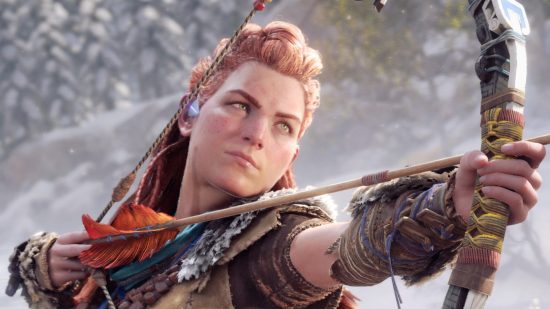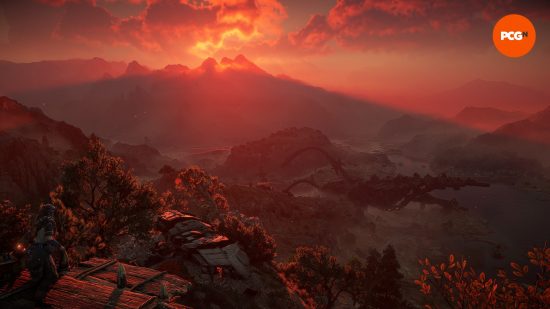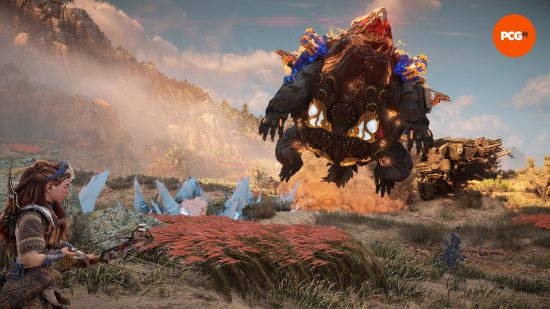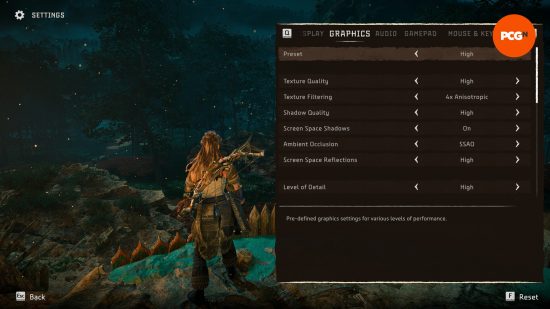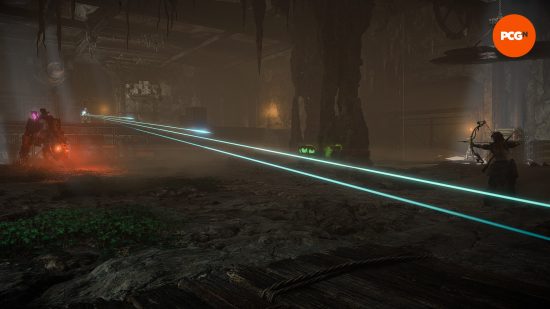Our Verdict
Horizon Forbidden West is utterly gorgeous and builds on the original's intense combat, but a lack of ambition and a flat narrative hold it back as a sequel. It provides more of the first game but bigger, with a few new inclusions struggling against the tidal wave of familiarity.
Sequels are a funny business, especially if the original turned out to be a massive success. You’re suddenly locked in, and you can’t change too much without the risk of alienating your staunchest fans. That’s the unenviable position Horizon Forbidden West, an overly safe follow-up to the smash-hit Horizon Zero Dawn, finds itself in.
It’s not that there isn’t anything new in developer Guerilla Games’ gorgeous open-world game. The developer has tweaked and refined the formula, mixing things up just enough to keep Aloy’s second journey through a robot-infested post-apocalypse from turning stale. Across the board, Forbidden West is bigger than its predecessor, boasting a larger world, a factory-load of fresh robots to face off against, and new combat options like smashing enemies with giant Resonator Blasts from your spear and flashy Valor Surge moves. Even traversal has been improved with the Shieldwing Glider letting you hop off any precipice without fear and the Pullcaster grappling hook opening up different ways to solve puzzles.
Combat remains a tense, tactical affair of observing the enemy, placing traps, executing your plan, then – somewhat inevitably – being thrust into a scrappy fight for your life. At least, that’s how I play it. You’ll explore the Forbidden West and delve into many caves and forgotten treasure troves from the old world, each layered with puzzles and draped with narrative moments that give you insights into what came before. It’s a dense game, filled with side quests, hunts to engage in, and even a chess-like minigame for you to while away the hours playing.
But it’s the Forbidden West itself that’s the true star of the show, which sits comfy among the most stunning game worlds seen on PC. With enhanced visual options meaning those with beefy rigs can pump the game beyond anything the PS5 can offer and a huge variety of biomes and intriguing sites both big and small to explore, this world cries out to be explored and soaked up. Just existing in Forbidden West’s vision of the post-apocalypse feels right, with the dust dancing around your feet as you watch robots snuffle around in the brush, the sun bursting out of clouds above to be reflected in glinting azure waters.
As a port, Nixxes Software has excelled at bringing Horizon Forbidden West to PC. This isn’t just a case of slapping the game onto PC and wishing us well; everything has been taken into account to ensure the port absolutely sings even on less powerful machines. My system, which includes an Nvidia GeForce RTX 3060 Ti and an Intel i5-10600K, squats on the recommended system requirements, yet I was able to crank everything up to high and still enjoy a solid frame rate throughout, with only some cutscenes and a few moments in the Burning Shores expansion causing the occasional jitter.
For those looking to tweak their experience, there’s a dizzying amount of options to trawl through, both before you launch the game and in-game thanks to an overlaid settings menu that lets you immediately see the impact of your changes. Everything the modern PC player might want is here: ultrawide support, DLSS, FSR, triple monitor support, and more all work seamlessly. Even playing with mouse and keyboard works well, though some menus are admittedly less intuitive to use than when playing with a controller. The only thing missing is ray tracing, but with the world looking this good already it’s hard to gripe about its omission.
If Horizon Forbidden West existed in a vacuum it would sit among the genre’s best, but there are some drawbacks to its sequel status that leave a slightly sour taste. The overwhelming one through my adventures is the nagging feeling that I’ve seen all this before. While there are new robots and fresh mechanics, it never feels like more than a Horizon Zero Dawn retread. There’s a new big bad to take on and a swathe of characters to meet, but the narrative and the structure of it all start to feel mechanical the second time around. The start of the game is especially familiar, going from a mostly on-rails section to a slightly open world before you’re eventually let loose on the Forbidden West itself.
The game’s narrative in particular suffers from being the middle child in the Horizon saga. It follows up on some threads from the previous game and lays the groundwork for the next, but the villain isn’t particularly notable and some of the reveals fall surprisingly flat. It’s a shame given how well the original game maintained interest through a skillful drip-feed of engaging lore and twists.
That said, the character writing is typically strong. I’m especially a fan of how Aloy’s experiences in the first game inform her personality in the sequel. She’s a harsher main character, more tired of dealing with superstitions about the past, and still suffering the trauma of her war against Hades. That combined with some of the inter-tribal conflicts you encounter as you explore these new lands does add color and shade to Aloy’s journey.
Unfortunately a pervading sense of sameness also applies to the experience of playing Horizon Forbidden West. Most of your time is spent doing largely the same tasks as in Horizon Zero Dawn. Climbing tallnecks to uncover more of the gargantuan map, fighting many of the same robots, dealing with bandit camps, collecting sticks to craft arrows, and so on. I’ve been there and seen it all. If it didn’t feel so good to play, it’d be verging on Horizon Zero Yawn.
Horizon Forbidden West never threatens to break the mold. It provides more of the first game but bigger, with a few new inclusions struggling against the tidal wave of familiarity. This prescriptive devotion to following the first game’s path makes Aloy’s latest stumble more than expected, especially when you factor in the weaker narrative. It’s a polished, iterative sequel with robust mechanics and one of the most stunning videogame worlds yet seen, but it’s hard to kick the feeling that it could have been so much more.
